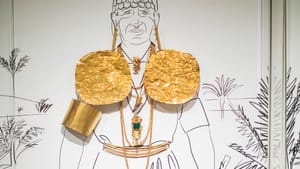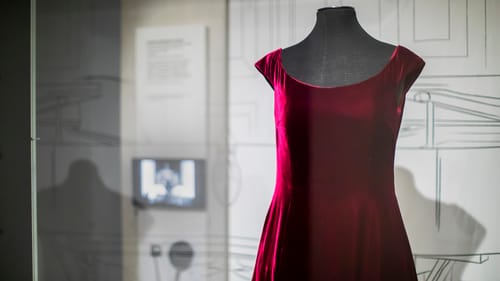Our selves, on our sleeves
Penn Museum presents The Stories We Wear

The Stories We Wear is all about the clothes. With garments spanning three millennia, Penn Museum’s new exhibition shows how people outfit themselves for specific purposes that have changed little over time. People dress to do a job, mark a milestone, defend themselves, assume authority, and command respect. Whether in 500 BCE or 2021, what we wear says who we are.
Star-struck visitors may be tempted to zero in on Princess Grace’s coral gown or Connor Barwin’s Eagles uniform, and give short shrift to artifacts belonging to names lost to time. To do so would mean missing resonant echoes between the ages; for instance, items used by a Scythian warrior 2,500 years ago and a gown worn by 20th-century vocalist Marian Anderson.
Velvet armor
How do the warrior’s belongings relate to Anderson’s merlot velvet gown? It was all worn in battle.
Over her accomplished career, the Philadelphia-born contralto (1897-1993) is most remembered for a 1939 concert at the Lincoln Memorial, a setting necessitated by racism—the Daughters of the American Revolution would not permit a Black performer to sing inside Washington D.C.’s Constitution Hall. Singing to an outdoor crowd of 75,000, Anderson became, and remained, a civil rights symbol, which made her every concert an assertion of equality. The gown on view, with short beaded train and matching slippers, was made in about 1938. Next to it, a listening post plays video and audio of Anderson singing My Country ‘Tis of Thee at the Lincoln Memorial.

Close by, the Scythian warrior’s decorations are artfully displayed on a life-size sketch. There’s a diadem of gold blossoms across the forehead, decorative buttons, flower ornaments, bracelets, an anklet, and ring, said to have been used in the 4th century BCE on the Eurasian steppe in Russia, where Scythian men and women fought side-by-side. Any of the bright items could be worn on a 21st-century red carpet and not look out of place.
Wealth and war
What women wore in the ancient city of Palmyra signaled not only wealth, but the ability to own property, hold office, and control trade. Thus Zenobia, queen of the Palmyrene Empire from 267 to 272 CE, would likely have adorned herself with items similar to those on view, including a stone and gold diadem, a sardonyx ring stamped with the image of the Roman goddess Victoria, and necklaces made from rock crystal, carnelian, and agate.
Queen Zenobia’s raiment is subdued compared with the golden regalia of a Coclé chief from 750 to 1000 CE, crafted to signify power. Worn in battle and for burial, the items include gleaming plaques the size of salad plates, inscribed with fearsome creatures, worn on the chest in battle to intimidate foes. At the chief’s death, two pairs of gold arm cuffs would have been added for burial.
Piercing was common among men and women in Coclé, a pre-Columbian province in what is now Panama, and chiefs were no exception: the exhibit includes a nose ring and ear rods.
Skin as canvas
Like piercing, tattooing is not new. A display of 19th-century tools from Borneo includes tattoo stamps, which were dipped in ink to create traceable designs on skin; a bowl for ink made from soot, sugar-cane juice, and water; and a terrifying needle that resembles a snaggly viper’s tooth on a 10-inch stick.
Women’s leg tattoos, done gradually over years, indicated social class. For men, tattoos signified important life events and offered protection from illness. A tattoo ringing a person’s wrist was thought to prevent the soul from escaping the body.
Bridal wear
Several artifacts relate to marriage traditions, and fascinating gallery text expands on their use in the ceremony, so universally central to family, community, and culture.
Among the Hopi, marriage is a prolonged experience blending two families, with relatives on both sides preparing the 10-day wedding ceremony. The kaolin-whitened buckskin boots and robe (mö’öngtotsi and tsaaq’wa oova) of an early 20th-century Hopi bride are on view. It was one of two made for her by the groom’s male relatives—the second would be kept for her burial. A feather tucked into her marriage robe represented a prayer for the new couple’s happiness, and the bride carries a sheaf of reeds, symbolizing falling rain.

In Mongolia, brides came into marriage with a trousseau of 10 garments they were expected to wear for the rest of their lives. Mongolian women also restyled their hair after marriage, to signify their changed state. On view are two 19th-century silver frames, infrastructure for hairstyles best described as architectural.
Two warriors
Warriors need protection, whether guarding against sharp objects or a good ground game. In the Pacific island nation Kiribati, when citizens engaged in ceremonial duels to settle disputes, they wore helmets and padded vests woven from the fiber of coconut husks. Tall, wide back guards, like overgrown shirt collars, rose from their shoulders to shield against thrown objects, and they carried weapons studded with shark teeth. From a distance, the 19th-century warrior resembles a contemporary US soldier in sand-colored camouflage.
Structurally, the warrior’s gear looks like what Connor Barwin wore as a defensive back for the Philadelphia Eagles from 2013 to 2016. An example from Barwin, now a member of the Eagles front office staff, towers at one end of the gallery, with steel, plastic, and synthetic replacing the warrior’s coconut fiber.
Courtiers and priests, office-dwellers and drag
The reasons humans dress as they do have changed little. A 19th-century Chinese court official dons a dark silk robe to meet the emperor for the same reason a 21st-century woman selects a navy suit for an important meeting. A 16th-century Buddhist priest, wearing a crown of enlightenment and carrying a relic box and shell prayer beads, evokes the clerics who inhabit modern churches, synagogues, and mosques. Performers wanting to hold attention have long worn eye-capturing costumes and transformative makeup, so the bustled fuchsia dress and wig worn by drag performer Eric Jaffe in 2018’s Thweeney Todd: The Flaming Barber of Fleet Street is, in a sense, timeless.
What we wear announces what we’re about. We wear our identity on our sleeves, and our clothes proclaim not only the stories we tell the world, but the ones we tell ourselves.
What, When, Where
The Stories We Wear. $13-18. Through June 12, 2022, at Penn Museum, 3260 South Street, Philadelphia. (215) 898-4000 or penn.museum.
Penn Museum follows current Covid-19 guidance from the Philadelphia Department of Health and Centers for Disease Control. Advance timed tickets, with a one-hour entry window, are strongly encouraged. Visitors are required to wear face coverings, stay three feet apart from those not in their household, and postpone visiting if feeling unwell. Hand sanitizer and wipes are available throughout the museum.
Accessibility
Each entrance to Penn Museum is wheelchair-accessible and accessible parking is available in the museum garage. Accessible and single-use restrooms are available. Some doors in the museum do not have power-assist. Staff are happy to help with unpowered doors. Elevators are available for all public spaces except the elevated Greece Gallery, which guests can access with a lift or a short flight of stairs. For more information, go to penn.museum/accessibility.
Sign up for our newsletter
All of the week's new articles, all in one place. Sign up for the free weekly BSR newsletters, and don't miss a conversation.
